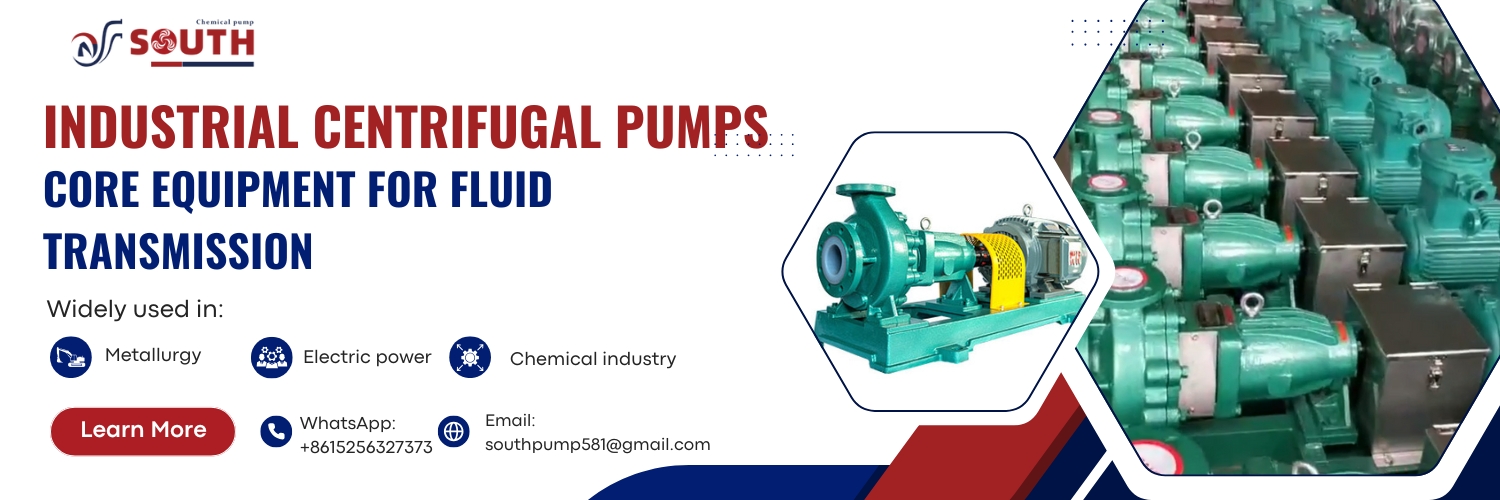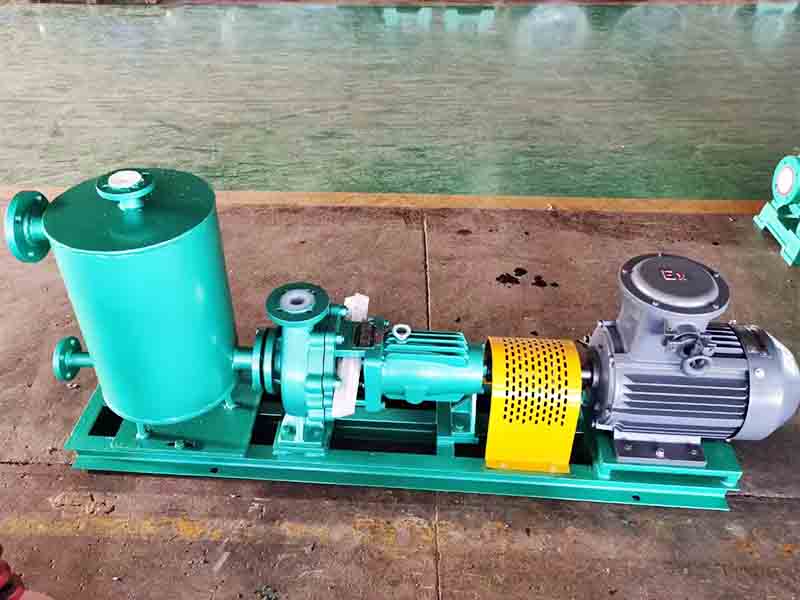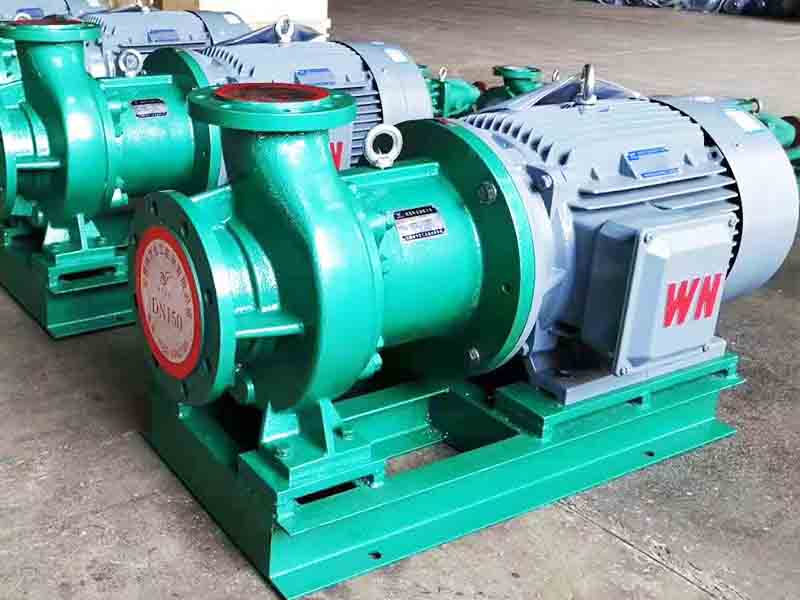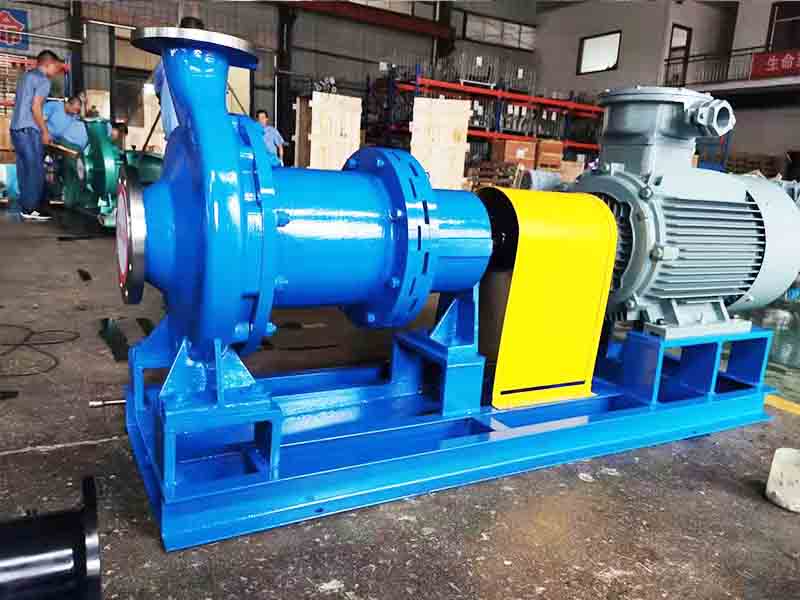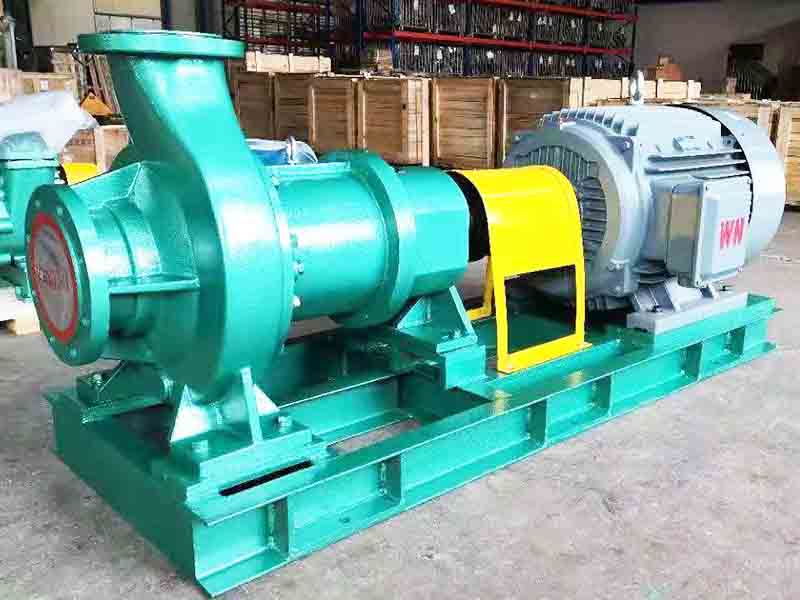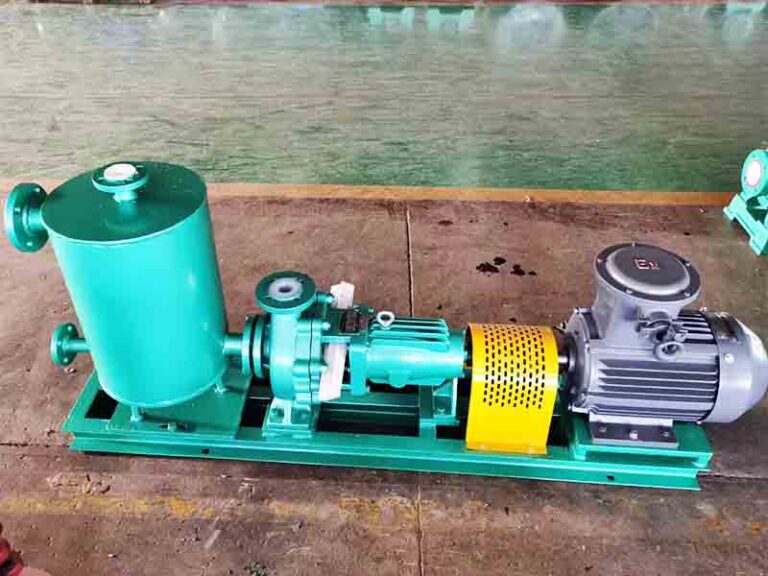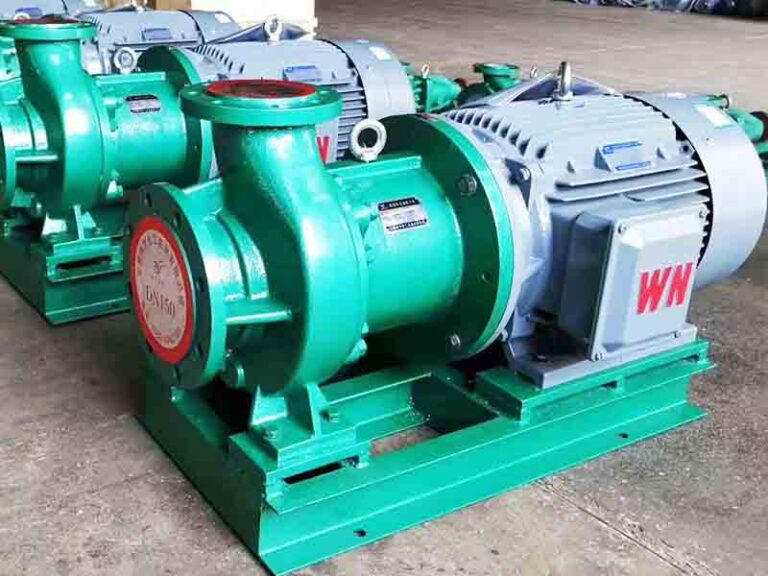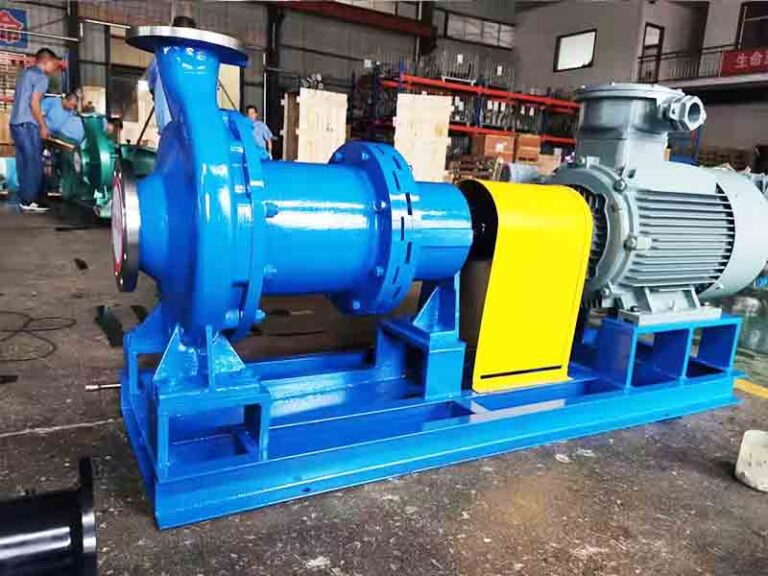In the huge system of industrial production, centrifugal pumps, as the core equipment for fluid transmission, are widely used in chemical industry, electric power, metallurgy, municipal water supply and many other fields, and play an irreplaceable role in ensuring the smooth operation of the production process.
As a key component of centrifugal chemical magnetic pumps, the correct selection of bearings is closely related to the performance, stability and service life of centrifugal pumps. Next, we will explore the centrifugal pump bearing type, for your comprehensive interpretation of the mystery.
What Are Industrial Centrifugal Pumps
A centrifugal pump is, in essence, a pressure-generating mechanical device. It is like a sophisticated and efficient energy converter, with the help of centrifugal force will be converted into kinetic energy fluid power energy, so as to promote all kinds of fluids in industrial and municipal processes in the continuous flow.
Pump Bearing Types Explained
Centrifugal Pump Workflow Explained
The fluid’s journey through a mag-drive pump begins at the inlet. It passes through a specially designed nozzle and strikes the impeller inside the magnetic pump at a precise angle and speed. The impeller acts as a high-speed rotating ‘power engine’ that spins at high speeds, driven by an electric motor and other actuators. As the impeller rotates, the fluid is endowed with powerful kinetic energy, as if it were injected with a ‘vitality factor’.
The fluid that has gained kinetic energy immediately enters the key part of the worm shell or diffuser. Here, the fluid’s flow rate gradually slows down, and according to the law of conservation of energy, its kinetic energy is converted into pressure energy, and the pressure can be significantly increased, and finally discharged from the outlet of the durable centrifugal pump to meet the high-pressure state of the process requirements, completing the entire conveying process.
Centrifugal Pumps Common Types Introduction
Axial and Mixed Flow Vertical and Horizontal Centrifugal Pumps
Axial Flow Centrifugal pumps are uniquely designed to flow fluids mainly in the axial direction within the centrifugal impeller pump. This type of pump in the large flow, low head conditions, like ‘Hercules’ in general, can easily cope with, and efficiently transport a large number of fluids.
Mixed-flow centrifugal pumps are a clever blend of axial flow and radial flow characteristics, it is in the flow and head of a wider range of adaptability, according to the actual needs of the process to flexibly adjust the operating parameters, suitable for a variety of complex and variable fluid transport scenarios. Vertical and horizontal installation form, and further expand their application space.
Vertical and Horizontal Centrifugal Pumps with Radial Flow
Radial flow centrifugal pumps show excellent performance in high head, medium and low flow operating conditions. Its internal structure is designed so that the fluid, under the action of the impeller, mainly obtains energy along the radial direction and is thrown out.
Vertical and horizontal structure design provides diversified options for its application in different industrial environments. In industrial production workshops, horizontal radial flow centrifugal magnetic pumps can be flexibly installed in different locations according to the layout of the process, supplying all kinds of production equipment with precisely the required fluids.
Electric, Engine and Hydraulic Driven Centrifugal Pumps
Electric driven centrifugal pumps have become one of the most widely used driving methods with its significant advantages of cleanliness, high efficiency and easy control. It only needs to be connected to a stable power supply, it can be quickly started and run stably according to preset parameters, which is perfectly adapted in most industrial production environments.
Engine-driven centrifugal pumps play an important role in remote areas where there is a lack of a stable power supply or where there are special requirements for equipment mobility.
Hydraulically driven centrifugal pumps in some of the flow and pressure control precision requirements of the high performance of special processes. For example, in the precision chemical production process, hydraulic centrifugal pumps can be accurately adjusted through the parameters of the hydraulic system.
Single-stage and Multi-stage Centrifugal Pumps
Single-stage centrifugal pumps are relatively simple in structure, consisting of an impeller and a corresponding pump body. It is suitable for some basic fluid conveying tasks with low pressure requirements, such as common industrial cooling circulating water conveying, water supply in small irrigation systems, etc.
Multi-stage centrifugal pumps, on the other hand, achieve a step-by-step increase in fluid pressure by connecting several impellers in series on the same shaft. In the petrochemical industry, multistage centrifugal pumps are useful when crude oil needs to be transported from low-pressure areas to high-pressure processing units.
Vertical Turbine and Vertical Sump Centrifugal Pumps
Vertical turbine centrifugal pumps are specially designed for pumping liquids from deep wells. Its unique structure enables the pump body to go deep into the well and lift the liquid from the bottom of the well to the surface through the rotation of the impeller.
Vertical catchment pit centrifugal pumps are mainly used for collecting and discharging liquids in catchment pits. In industrial plants, basements and other places where water is likely to accumulate, vertical catchment pit centrifugal pumps can pump out the accumulated water in time, avoiding damage to equipment and buildings caused by accumulated water, and guaranteeing the safety and normal operation of the production environment.
Submersible Pumps
The most important feature of submersible pumps is that they can work completely submerged in liquid. This feature makes it widely used in the fields of sewage treatment, mine drainage, pond breeding oxygenation and so on.
In the sewage treatment plant, submersible pumps can be placed directly in the sewage pond, the sewage will be pumped out and transported to the subsequent treatment process; in the pond culture, submersible pumps can be stirred through the water, increase dissolved oxygen and other ways for fish and other aquatic organisms to create a good living environment.
Which bearings are more suitable for use on multistage centrifugal pumps
Pump Bearing Basic Knowledge
pump bearing in the operation of centrifugal pumps, plays a key role as human joints. It bears the heavy responsibility of supporting the rotating parts, so that the pump shaft can be under load to achieve smooth and efficient rotation. Pump bearings of various types, and according to the type of load it can withstand, can be broadly divided into radial bearings, axial bearings, and can simultaneously withstand radial and axial loads of the combination of bearings and so on.
Different types of bearings in the structural design, material selection and manufacturing process are different, these differences determine their unique performance characteristics and scope of application to meet the centrifugal chemical pump in a variety of complex operating conditions.
Single-row Deep Groove Ball Bearing
Appearance and Structural Characteristics
Single-row deep groove ball bearing has a simple and classic structure. It mainly consists of inner ring, outer ring, a set of steel balls and cage. The inner ring and outer ring relative installation, the middle of the steel ball in the cage under the guidance of uniform distribution, forming a smooth rolling movement system.
This structure design makes the single row deep groove ball bearings in the rotating process, the steel ball can maintain good contact with the inner and outer ring raceway, so as to achieve efficient energy transfer and low friction operation.
Adapt to the Characteristics of Different Fluid Conveying Scenarios
In order to better adapt to the non-leakage magnetic pump conveying different types of fluids in the working environment, single row deep groove ball bearings have the characteristics of adding dustproof or oil seal. When the centrifugal pump is used for conveying fluids containing dust, impurities and other particles, the addition of dustproof oil seals can effectively block these particles from entering the bearing, avoiding particles on the steel ball and raceway wear, thus extending the service life of the bearings.
In the transport of corrosive chemical fluids, the use of special materials, oil seals, can prevent fluid contact with the metal parts of the bearings, play a good protective effect, to ensure that the bearings in the harsh chemical environment can still work properly.
Load Bearing Capacity Analysis
single row deep groove ball bearings in the load bearing, mainly to bear radial load. In the centrifugal pump operation process, due to the impeller’s high-speed rotation and fluid on the impeller force, will produce a certain radial force, single row deep groove ball bearing can rely on its structural characteristics, this part of the radial force uniformly dispersed to the inner and outer rings and balls, to ensure the stable operation of the bearing.
At the same time, it also has a certain axial load bearing capacity, although the relative radial load bearing capacity is weak, but in some small axial force conditions, can still effectively play a role in ensuring that the alkali centrifugal pump shaft in the axial direction of the position of the stability.
Advantages Explained
Outstanding high speed performance: The structure design of single row deep groove ball bearings makes it able to maintain good running condition under high speed. The low friction between the steel ball and the raceway makes the bearing produce less heat when rotating at high speed, which can effectively avoid the performance degradation and life shortening caused by overheating, and it is suitable for centrifugal pumps to operate under high speed working conditions.
Compound load bearing capacity: although it mainly carries radial load, but to a certain extent, it can also bear axial load. This kind of compound load bearing capacity makes single row deep groove ball bearings work under many kinds of working conditions in centrifugal pumps, and improves the versatility and applicability of the bearings.
Low friction coefficient: the steel ball and raceway inside the bearing adopt high-precision processing technology and high-quality lubrication material, which makes the friction coefficient extremely low. This not only helps to improve the operating efficiency of the corrosion-resistant centrifugal pump and reduce energy consumption, but also reduces the noise and vibration during the operation of the equipment and improves the overall stability of the equipment.
Low manufacturing cost: due to its relatively simple structure, mature manufacturing process, the raw materials required are also more common, so the manufacturing cost of single row deep groove ball bearings is relatively low. This advantage makes it in the large-scale application in the field of centrifugal pumps, can effectively reduce the overall manufacturing cost of equipment, improve the economic efficiency of enterprises.
Disadvantages of Analysis
Shock load carrying capacity is weak: the structural characteristics of single row deep groove ball bearings decided to face the shock load is more fragile. When the centrifugal pump in the process of starting, stopping or running encountered sudden fluid impact, the steel ball and raceway inside the bearing is easy to be instantaneous high stress, may lead to steel ball rupture, raceway scoring and other damage phenomena, affecting the normal service life of the bearing.
Relatively large radial size: compared with some plain bearings, the radial size of single row deep groove ball bearings is larger. In some of the high temperature centrifugal pump structure compactness requirements of the application of the scene, such as some special miniaturised industrial equipment or the space layout is extremely limited places, the larger radial size may give the equipment installation and arrangement of certain difficulties, limiting the scope of its application.
Double Row Angular Contact Ball Bearings
Unique Design Structure Explained
Double Row Angular Contact Ball Bearings adopt a unique design concept, which arranges two rows of steel balls next to each other in the same housing. This design makes the bearing more compact in structure, and also gives it special performance advantages. The arrangement of two rows of steel balls can effectively disperse and bear loads from different directions, improving the overall bearing capacity of the bearing.
Load Bearing Advantage Description
The biggest advantage of double row angular contact ball bearings is that it can simultaneously withstand axial loads from two directions as well as large radial loads. In the centrifugal pump operation process, when the fluid on the impeller to produce complex force, bearing not only to withstand due to the impeller rotation generated by the radial force, but also may face the impact of axial thrust from the fluid. Double-row angular contact ball bearings, with its special structure, can evenly distribute these complex loads to the two rows of steel balls, to ensure that the bearings can still run stably under the compound load conditions, providing a solid guarantee for the reliable operation of the alkali centrifugal pump.
Economic and Space Advantage Elaboration
From the point of view of economy and space utilisation, double row angular contact ball bearings have significant advantages. In some traditional design, in order to meet the demand of bearing axial and radial loads at the same time, it is often necessary to use two single-row angular contact ball bearings in combination. The double row angular contact ball bearings can directly replace this combination, not only reduces the purchase cost of bearings, but also saves the installation space.
In some of the equipment volume and cost control is more strict in the industrial project, this advantage is particularly prominent, can help enterprises in the premise of ensuring the performance of the equipment, effectively reduce the cost and optimise the structure of the equipment.
low running noise, Adapt to the Characteristics of Tilting motion Introduction
In the process of operation, double row angular contact ball bearings show a low noise level. This is because of the uniform distribution of the two rows of steel balls and the precision manufacturing process, which makes the bearing maintain good dynamic balance during rotation, reducing the vibration and noise caused by imbalance. In addition, the bearing is also well adapted to the tilting motion that may occur during the operation of the pump shaft.
When the centrifugal pump shaft is tilted at a certain angle due to various reasons during installation or operation, double-row angular contact ball bearings can effectively compensate for this tilt through their own structural adjustment without affecting the normal operation, avoiding premature wear and damage to the bearings due to the tilt of the shaft.
The Disadvantages of High Mounting Accuracy Requirements and Low Shock Load Carrying Capacity
Double row angular contact ball bearings also have some shortcomings.
Firstly, due to its more complex structure, the requirements for mounting accuracy are extremely high. In the installation process, it is necessary to ensure that the position of the two rows of steel balls is precise and accurate, as well as the matching accuracy between the bearing and the pump shaft and bearing housing meets the design requirements.
Secondly, although the double-row angular contact ball bearings perform well in withstanding regular loads, their bearing capacity is relatively low when facing shock loads.
Universal paired single-row angular contact ball bearings
Unidirectional High Axial Load Bearing Characteristics emphasised
One of the most significant features of universal paired single-row angular contact ball bearings is that they have a strong unidirectional high axial load bearing capacity. The design structure of this bearing enables it to withstand extremely high axial force in a specific direction.
Under some special working conditions of centrifugal pumps, such as conveying high pressure and high viscosity fluids, a large axial thrust may arise, and at this time the universal paired single-row angular contact ball bearings will be able to play its unique advantages, effectively resist axial force, and ensure the stable operation of the pump shaft.
High and Low Shoulder Design to Accommodate a Large Number of Structural Advantages of Steel Ball
In order to achieve a strong axial load carrying capacity, universal paired single row angular contact ball bearing adopts a unique high and low shoulder design. This design makes the inner or outer ring of the bearings have a high shoulder and a low shoulder, which can accommodate a large number of steel balls through the clever structural layout. More steel balls means a larger bearing area and stronger load dispersing ability, which enables the bearings to withstand high axial loads while maintaining good operational stability and reliability.
Pair use of the Application Mode Description
In practice, universal paired single row angular contact ball bearings are usually used in pairs. This is because in the centrifugal pump operation process, in addition to axial load, there will be a certain radial load. When the radial load acts on the stainless steel chemical pump shaft, it may lead to unwanted axial displacement of the shaft, affecting the normal operation of the equipment.
By installing two universal paired single-row angular contact ball bearings in pairs and making their axial force in the opposite direction, the axial displacement caused by the radial load can be effectively offset to ensure that the pump shaft always maintains a stable position under the complex loading conditions, and to improve the operating accuracy and reliability of the centrifugal pump.
Advantages Listed
Very high axial load bearing capacity: as mentioned earlier, universal paired single row angular contact ball bearings in the unidirectional axial load bearing performance excellence, able to withstand higher axial force than the general bearing, for the centrifugal pump in the high axial load conditions of the stable operation of the pump to provide a strong guarantee.
Good dynamic response performance: the bearing can well cope with the rapid acceleration and deceleration changes of the centrifugal pump in the process of starting, stopping and running. Its structural design enables the steel ball to quickly adjust its position and maintain a good rolling state when the load changes, which effectively reduces the wear and fatigue caused by dynamic load changes and prolongs the service life of the bearing.
Easy to pair: universal pairing single row angular contact ball bearings have good generality and interchangeability, in the actual installation process, different batches of bearings can be conveniently paired combination, without the need to carry out complex adjustment and matching work, greatly improving the installation efficiency and equipment maintenance convenience.
Easy installation: compared with some other types of bearings, universal paired single row angular contact ball bearings do not need to carry out complex internal clearance or preload adjustment in the installation process. Just follow the correct installation method to install them on the pump shaft and bearing housing, can ensure the normal working condition of the bearings, reduce the installation difficulty and the requirement of professional skills of the installers.
Disadvantage Analysis
Bearing housing design is complicated: due to the special structure and application mode of universal paired single-row angular contact ball bearings, it is necessary to have the corresponding design characteristics of the bearing housings matched with them. In order to meet the installation and working requirements of the bearing, the design of the bearing housing is often more complex, need to consider a number of factors, such as the positioning of the bearing, the fixed way, and how to effectively transfer the load and so on.
Higher initial cost: universal paired single row angular contact ball bearings have high standards in material selection, manufacturing process and quality control to ensure that they have strong performance. These factors lead to the initial purchase cost of the bearing is relatively high. For some cost-sensitive industrial projects or enterprises, the higher initial cost may limit its application scope to some extent.
Bearing Selection Strategies for Multi-stage Centrifugal Pumps
The Importance of Multi-stage Centrifugal Pumps in Industry
Multi-stage centrifugal pumps occupy a pivotal position in the field of industrial production. It is widely used in the key links of liquid transport and fluid pressurisation, and is one of the core equipment for many industrial processes to be carried out smoothly.
In the petrochemical industry, multistage centrifugal pumps are used to transport crude oil from the extraction site to the refinery, and in the refining and chemical production process, various raw materials and intermediate products are transported at high pressure to ensure the continuity and stability of the production process.In addition, in metallurgy, papermaking, pharmaceuticals and many other industries, multistage centrifugal pumps also play a key role in providing a reliable fluid transport guarantee for industrial production.
Applicability Analysis of Common Bearing Types in Multi-stage Centrifugal Pumps
Deep Groove Ball Bearing
Load Carrying Capacity and Suitable Scenarios: Deep groove ball bearings in multi-stage centrifugal pumps mainly bear axial loads as well as a certain degree of radial loads. Its compact structure, internal steel ball and raceway design makes it outstanding in high-speed operation scene.
Limitation analysis: however, deep groove ball bearings have obvious short board. When faced with large radial load, its bearing capacity is insufficient, which easily leads to excessive wear of steel ball and raceway, affecting bearing life.
Contact Ball Bearings
Load bearing characteristics and advantages: Contact ball bearings can withstand large radial and axial loads at the same time. Its high stiffness and high precision characteristics, make it in the high-speed operation and the working environment requirements of the multistage centrifugal pump in the performance of excellence.
Lubrication and sealing points: In order to ensure normal operation and long service life, contact ball bearings on the lubrication and sealing requirements are extremely strict. Suitable lubricant can reduce friction and wear, prolong the service life of bearings; good sealing can prevent external impurities, moisture and other intrusion, to avoid bearing corrosion and abnormal wear.
Cylindrical Roller Bearings
Strong load carrying capacity: cylindrical roller bearings have significant advantages in withstanding large axial thrust and radial load. In the multi-stage centrifugal pump conveying high pressure, high viscosity liquid, will produce a large axial and radial force. Cylindrical roller bearings by virtue of its unique structure, roller and raceway line contact, can effectively dispersed and withstand these high loads, and has a good wear-resistant performance, to ensure that the long-term stability of operation in poor working conditions.
Installation layout points: but its longer structure leads to occupy more space, in the design of multi-stage centrifugal magnetic pump, need to fully consider the installation layout. For example, reasonable planning of the internal structure of the pump body to ensure that the cylindrical roller bearing installation space is sufficient, while paying attention to the location of the relationship with other components.
Multi-stage Centrifugal Pump Bearing Selection Summary
Multi-stage centrifugal pump bearing selection needs to consider the specific application scenarios and working conditions. Deep groove ball bearings are suitable for high speed, relatively stable load and small impact conditions.
Contact ball bearings need to withstand large radial and axial loads at the same time, the best performance of the occasions of high precision requirements; cylindrical roller bearings is a high axial and radial load scenarios of the choice.
How to Choose the Right Bearings for Centrifugal Pumps
Installation
Installation is the key first step in deciding whether the bearing can play a normal performance. When installing, make sure that the bearings are accurately aligned with the pump shaft and bearing housing and firmly in place. The installer should strictly follow the installation manual and use professional alignment tools, such as laser alignment instrument, to precisely adjust the position of the bearings to ensure that the installation accuracy is within the permissible error.
Lubrication
Follow the manufacturer’s guidelines to add lubricant: adding the appropriate lubricant in strict accordance with the manufacturer’s recommendations is the core point to ensure the normal operation of the bearing. Different types of bearings and working conditions, the lubricant requirements vary greatly. Ordinary mineral oil-based lubricants are suitable for general working conditions. In high-temperature environments, synthetic high-temperature grease is required.
Applicable scenes of different lubricants: grease lubricant with strong adhesion and good sealing is suitable for low speed, high load and dust and other harsh environments, such as centrifugal pumps for mines. Oil lubricant with good mobility and fast heat dissipation is suitable for high speed and light load conditions, such as high speed centrifugal mag-drive pumps for chemical production.
Hybrid lubrication system combines the advantages of both, and has excellent performance in complex working conditions, such as self-priming pumps with frequent starting and stopping and large load variations. Hybrid lubrication system combines the advantages of the two, excellent performance in complex working conditions, such as frequent start and stop, load changes in the pump.
Monitoring Link
Introduction of monitoring methods: Regular monitoring of bearing operating conditions is an effective means of preventing failures. Temperature monitoring is one of the commonly used methods, through the installation of temperature sensors in the bearing housing, real-time grasp of the bearing temperature. Once the temperature rises abnormally, it may indicate poor lubrication, excessive load or internal bearing damage. Vibration monitoring is also critical, with the help of vibration analyser to detect the frequency and amplitude of bearing vibration, if out of the normal range, indicating that the bearing may have wear, fatigue and other problems.
Develop monitoring cycles and standards: enterprises need to be based on the frequency of use of centrifugal pumps, working environment and other factors, to develop a scientific and reasonable monitoring cycle. For continuous operation, poor working conditions of the mag-drive pump, daily or even every shift should be monitored; intermittent work and stable working conditions of the pump, you can appropriately extend the monitoring interval.
Cleaning and Replacement Link :In the process of use, the bearing is easy to contact impurities and pollutants, regular cleaning is necessary. Special cleaning agents can be used to remove surface dirt, metal debris, etc., to keep bearings clean and reduce the risk of wear. When bearings show serious wear, fatigue cracks, excessive clearance and other problems, they should be replaced in time. When replacing, choose bearings that are consistent with the prototype model and of reliable quality, strictly follow the replacement process, and ensure that they are installed correctly.
Disposal of waste Bearings
Proper disposal of waste bearings is a matter of environmental protection and safety. Waste bearings may contain heavy metals and other hazardous substances, which will pollute soil and water if they are discarded. Repairable bearings can be recycled and reused for refurbishment. If they cannot be repaired, they should be handed over to professional recycling organisations for harmless treatment according to environmental protection requirements, so as to avoid causing harm to the environment.
Centrifugal Pump Bearing Selection of Key Considerations
Load Type and Load Carrying Capacity
When choosing bearings, the first clear its main load type. If the heavy radial load, such as large mining centrifugal pumps, roller bearings are ideal, its line contact or surface contact structure can effectively disperse radial force. If the axial load is dominant, such as ship propulsion pumps, angular contact ball bearings can provide stable axial support.
Running Speed
High-speed pumps have very high demands on bearings, which require low friction and high RPM precision bearings. These bearings often use high-quality materials and advanced manufacturing processes, such as ceramic ball bearings, with low friction, high hardness, high temperature resistance and other characteristics, can maintain stability in high-speed rotation, reduce heat generation and wear, to ensure that the centrifugal pump high-speed operation of reliability and stability.
Lubrication Method
According to the working temperature, speed and load conditions of the centrifugal pump, choose the appropriate lubrication method. Under high temperature environment, choose high temperature resistant lubricant. When running at high speed, ensure that the lubricant is good heat dissipation. High load conditions require lubricants with strong carrying capacity.
At the same time, consider the convenience of lubrication and maintenance costs, such as automatic lubrication system can reduce manual intervention, improve equipment operating efficiency.
Environmental Conditions
If standard centrifugal pumps work in harsh environments, where contaminants, moisture or extreme temperatures exist, bearings with special coatings or seals need to be selected. For example, in seaside chemical enterprises, bearings are susceptible to salt spray corrosion, and anti-corrosion coated bearings can enhance corrosion resistance.
Alignment and Mounting
Correct mounting and alignment is the basis for prolonging bearing life. Installation in strict accordance with the operating procedures to ensure that the bearing and shaft, bearing housing with precision. Regular maintenance and inspection of alignment, timely correction of misalignment problems, can effectively reduce bearing wear. Reduce the probability of failure, improve the stability and reliability of centrifugal pump operation.
Conclusion
Choosing the right bearing is essential for improving centrifugal pump efficiency, reliability, and service life. Each bearing type suits different load and speed conditions, so careful selection and proper maintenance are key. By matching bearing types to application needs and following best practices in installation and upkeep, engineers can ensure stable pump performance, reduce downtime, and support smooth industrial operations.
